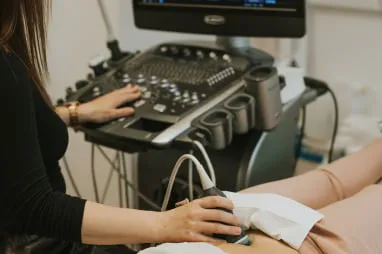What to choose: NIFTY test or nuchal translucency scan?
The health of the child is one of the biggest concerns of future parents. Therefore, in addition to the joyful expectation of pregnancy, we are often meet with the question: “Is my baby healthy?” For the answer to this question, you can turn to prenatal tests. Among them, the most popular are the nuchal translucency scan and NIPT test. What are the key differences between them and which one to choose?
Overview of nuchal translucency
Nuchal translucency is the thickness of the pocket of liquid under the skin on the fetus’ back. A gynaecologist can measure it with an ultrasound. The examination of nuchal translucency is both non-invasive and harmless to the fetus. It is usually performed via the abdominal wall, or, less commonly, vaginally.
Nuchal translucency scan primarily assesses the likelihood of chromosomal defects T21 (Down syndrome), T18 (Edwards syndrome), and T13 (Patau syndrome), which are also the most common chromosomal defects of the fetus. These defects are characterised by increased thickness of the pocket of liquid.


Normal nuchal translucency thickness is up to 2.5 mm, and anything above means an increased likelihood of fetal abnormalities. The value indicating a significantly increased chance of chromosomal or heart defect is estimated at 3.5 mm or more. However, the age of the mother is also crucial for the risk assessment itself, as the potential for chromosomal defects increases significantly with the age of the woman.
Gynaecologists perform the nuchal translucency scan between weeks 11 and 14 of pregnancy. The test itself lasts between 15 and 20 minutes. Usually, the gynaecologist performs a thorough general examination of embryonic development and determines the estimated date of delivery. Many gynaecologists also decide to examine the length of the cervix, the cranial anatomy of the fetus, its spine, stomach, kidneys, bladder and determine the presence of all four limbs. With this, the gynaecologist can detect possible other abnormalities in the development of the fetus.
What is the NIFTY by GenePlanet test, and how is it performed?
NIFTY by GenePlanet is a non-invasive prenatal screening test that detects Down, Edwards, and Patau syndrome, sex chromosome aneuploidies, and deletion and duplication syndromes that can affect fetal development. In cases of deletions and duplications, the number of chromosomes is normal, but only a fraction of the chromosome is missing or duplicated.


Only 10 ml of mother’s blood is required to perform the NIPT test, as cell-free fragments of fetal DNA are present in maternal blood. These are short fragments of DNA circulating in the blood. And by taking a sample of the mother’s blood, we can obtain the genetic material of the fetus and thoroughly examine it using NIFTY by GenePlanet technology.
This method offers extremely accurate results (more than 99% accuracy for the three most common trisomies) regardless of the patient’s clinical symptoms. The test also offers a more comprehensive range of testing options, including other trisomies, sex chromosome aneuploidies, and deletion and duplication syndromes.
The test can be done from week 10 of pregnancy when the mother’s blood contains enough fetal hereditary material. This means that the fraction of fetus’ cell-free DNA has reached the limit of 3.5%, which is the lowest amount for performing the NIFTY by GenePlanet test. As it only requires a sample of pregnant woman’s venous blood, the NIPT test is entirely risk-free for her and the fetus. The sample goes to the lab, and the results can be available within 6-8 working days.
Accuracy of results
Overview of nuchal translucency
The biggest drawback of the nuchal translucency scan is that it identifies only between 70 and 80% of fetuses with Down syndrome. Out of 100 embryos examined, the presence of the syndrome won’t be identified in 20 to 30 cases. Therefore gynaecologists usually suggest adding a double hormonal test (measuring betaHCG and PAPP in the mother’s blood), which increases the positive predictive value to 85-90%.
A nuchal translucency scan also provides approximately 5% of false positives, which is problematic as this may unnecessarily expose pregnant women to the risk of invasive diagnostic tests.
Lisateabe vaatamiseks pühkige horisontaalselt | |||
|---|---|---|---|
Screening | Week | Detection rate | False-positive rate |
Nuchal translucency ultrasound | 10-13 | 82-87% | 5% |
Blood test | 12-13 | 82-87% | 5% |
Multiple marker screening test (Triple test) | > 12 | 70% | 5% |
Quadruple test (Quad screen) | 15-18 | 81% | 5% |
NIFTY by GenePlanet | 10 | 99,02% | 0,14% |
Risk of 1:300 or more?
If a gynaecologist concludes that the risk of chromosomal abnormality in the feetus is 1:300 or higher, he will suggest further tests. The only way to detect chromosomal abnormalities with 100% certainty is an invasive diagnostic test – chorionic villus sampling or amniocentesis. Such tests have up to 1-2% risk of abortion, so it is not an easy decision.
Fortunately, you can choose to take the NIFTY by GenePlanet test before the invasive test.
The NIFTY by GenePlanet test
The NIFTY by GenePlanet test is much more accurate than the nuchal translucency scan. Its detection rate for the three most common trisomies present at birth is higher than 99%.
A significantly lower percentage of false-positive results is also a significant advantage:
As a result, fewer pregnant women are unnecessarily exposed to the risk of invasive diagnostic methods.


Which test to choose?
The nuchal translucency scan and the NIPT test are not mutually exclusive. The nuchal translucency scan can also detect other morphological abnormalities which a genetic test cannot. At the same time, the nuchal scan is not as accurate as NIFTY by GenePlanet. To have a truly peaceful pregnancy, choose to do both.